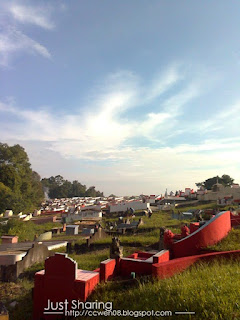Dim Sum is a Cantonese term which refers to Chinese cuisine involving wide range of light dishes served in small portion for the purpose of snacking normally during morning time.
[The Siu Mai or Sio Bi]
Dim Sum is not a common delicacy in Sibu as Sibu people prefer
cost-effective with maximum energy supply's foods for breakfast where Kampua is the most symbolic representation in this group. Furthermore, cooking Dim Sum needs higher food preparation skills which is not easy to master. Therefore, as long as Sibu eating culture is concern, I think better open a Kampua stall than troubling yourself with the Dim Sum business. The former give you an easier path to be a rich man so why choose the latter?
[3 different flavors in a steamer basket]
However, that doesn't mean that you can't find Dim Sum in Sibu. You can find it at specific eateries spots and one of them is the one I visited with a friend on last Sunday - Farley food court.
[The phoenix claw i.e. chicken feet]
There are variety of Dim Sum to choose from at this spot. The place is full of patrons looking for the food as well as other breakfast, so you don't expect to see the situation like in Hong Kong drama where the waiters or waitresses are pushing a trolley around selling Dim Sum from table to table.
[Prawn in it]
Here you just have to help yourself - queuing at the Dim Sum stall waiting for your turn, choose the Dim Sum you would like to try out, take it to the table you are seated then you can enjoy the foods.
[Qiong Fan]
Dim Sum are usually served in steamer basket as most of these foods are steamed. Some others like "Qiong Fan" is served in small plate. Normally there are only 3 pieces of Dim Sum inside each basket. As the portion is small, therefore usually people love to order more variety to get more stimulation to their gustatory sense.
[Spare ribs]
The price is quite reasonable. One serving is RM3.50 but if you order 3 at once then you will get a condolence discount of 50 cents. So, it's 3 for RM10.
[Glutinous rice - coarse and not well-cooked]
The taste? Well, I would say not too impressive but not too bad. Just moderate. I personally feel that the Dim Sum here are a little bit coarse in term of the texture as well as the taste. Improvement could be done on this.
[Pork innards]
[Curry chicken can also count as Dim Sum?]
We ordered this ice-blended mango drink. Very tall corn-shape glass and it is nice in presentation. It tasted not bad too! One cup of the drink costs RM3.90.
[Ice-blended mango drinks]
Besides all the above, my friend also ordered
Kueh Chap for each of us! Gosh! My stomach was terribly full that morning but it was really enjoy to taste so many foods at once!
[Kueh Chap]



















